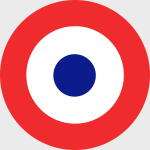
Bloch M.B.152 Fighter - 2nd Lt. Maurin, 4th Squadron, Fighter Group GC II/1, Couvron, France
Check my rate
| Main centres: | 1-3 business days |
| Regional areas: | 3-4 business days |
| Remote areas: | 3-5 business days |

| Main centres: | 1-3 business days |
| Regional areas: | 3-4 business days |
| Remote areas: | 3-5 business days |
 The Bloch M.B.150 was a French low-wing, all metal monoplane fighter aircraft with retractable landing gear and closed cockpit developed by Societé des Avions Marcel Bloch as a contender in the 1934 French air ministry competition for a new fighter design.
The Bloch M.B.150 was a French low-wing, all metal monoplane fighter aircraft with retractable landing gear and closed cockpit developed by Societé des Avions Marcel Bloch as a contender in the 1934 French air ministry competition for a new fighter design.
Although the competition was won by the prototype Morane-Saulnier M.S.406, development proceeded culminating in the first attempted flight of the M.B.150.01 prototype in 1936. Unfortunately, the plane proved unable to leave the ground! With modifications consisting of a strengthened wing of greater area, revised landing gear, and installation of a 940 hp (701 kW) Gnome-Rhone 14N-0 radial engine with a three-blade constant speed propeller, the M.B.150 finally flew in October of 1937.
Handed over to the Centre d'Essais du Materiel Aerien (CEMA) for service trials, its performance proved sufficiently interesting to warrant further development. This brought, at the very beginning of 1938, a small increase in wing span and installation of a 14N-7 engine. When trials were completed in the late spring of 1938, SNCASO was awarded an order for a pre-production batch of 25 of these aircraft.
No such production of the M.B-150.01 ever occurred, the plane being totally unsuitable to mass production. Redesign would lead to the M.B.151 and M.B.152 prototypes, developed and produced in parallel. By the outbreak of World War II, some 120 had reached the Armée de l'Air, but few of them were flyable, most missing their gunsights and propellers.
The M.B.153 and M.B.154 were intended as testbeds for American engines, but only the former flew, and when it crashed a few days later, damaged beyond repair, pursuit of these alternatives also ceased. Instead, attention shifted to extending the range of the M.B.152. This was achieved by moving the cockpit aft in order to make room for a new fuel tank. Other modifications included a slightly broader wing and revised aerodynamics around the cowling. The result, designated M.B.155 performed favorably in flight tests and was ordered into production in 1940, however only 10 aircraft had been completed by the fall of France. Under the terms of the armistice, the remaining 19 on the production line were completed and delivered into Vichy service. From there, some eventually made their way into the Luftwaffe after 1942.The final member of the family, the M.B.157 utilized a far more powerful engine and eventually became a very different aircraft as the design evolved to accommodate the larger and heavier powerplant. Unfinished at the time of the armistice, it was ordered to be completed and flown under German supervision. Demonstrating superb performance, it was taken to Orly where it was dismantled for testing. The engine was shipped to Germany, and the airframe evaluated in a wind tunnel, confirming the excellence of the design. It was later destroyed in an air raid.
Dimensions:
Wingspan: 5.75 inches
Length: 5 inches